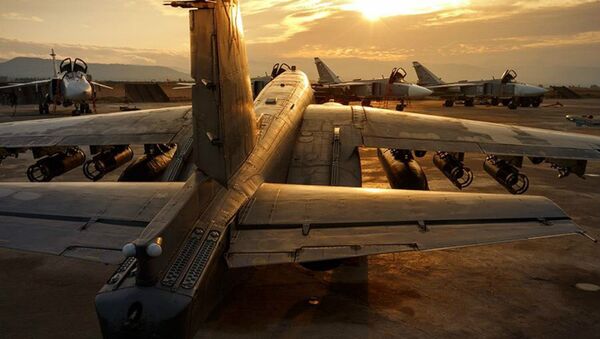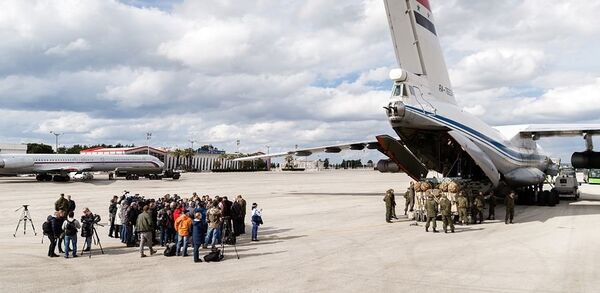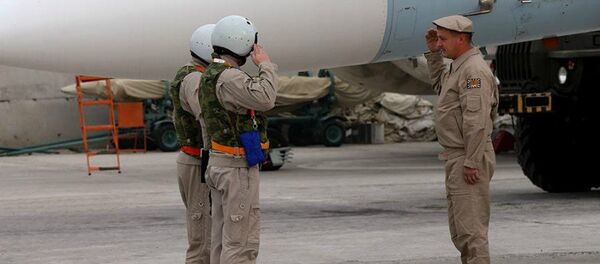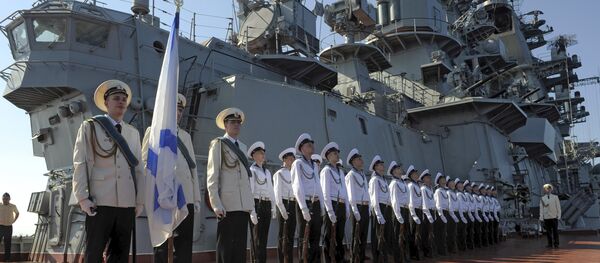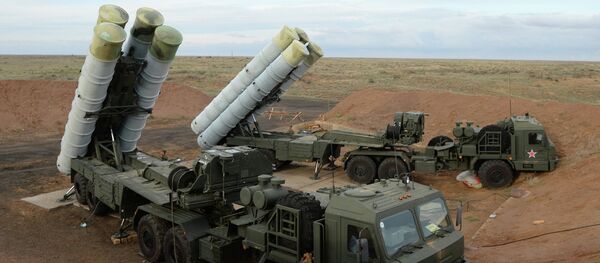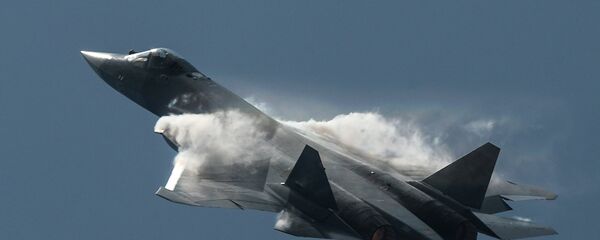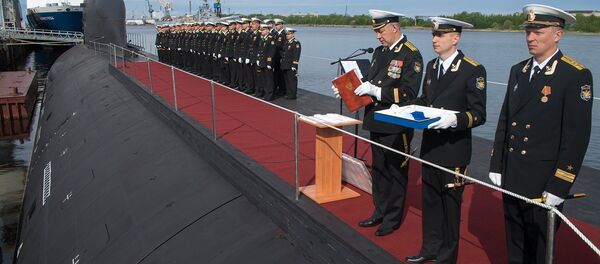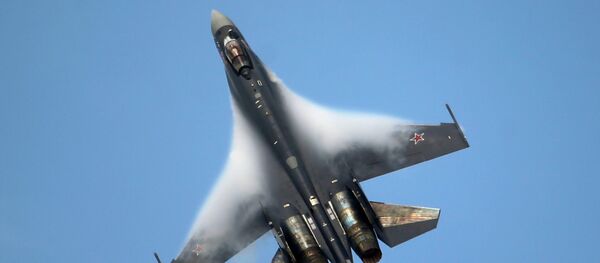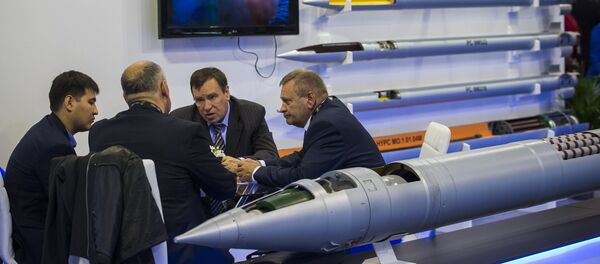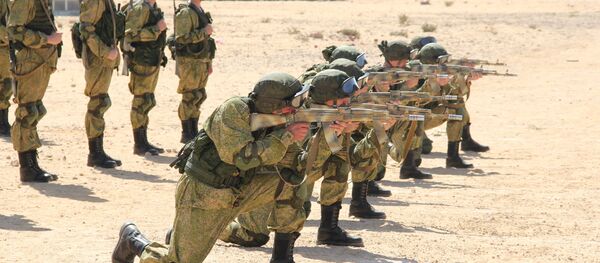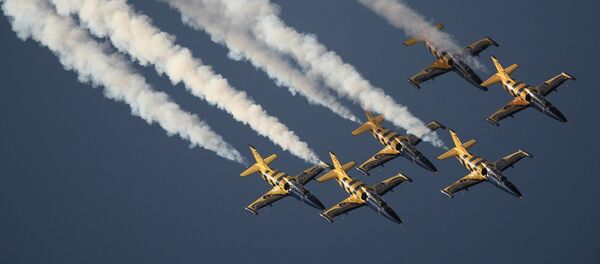MOSCOW (Sputnik) — Next year will see Russia carrying out a wide range of activities in the military sphere, including the drills, signing exports agreements with other countries, military exhibitions and the continuation of the anti-terrorist operation in the Middle East.
Creation and commission of advanced weapons is also expected to take place in Russia next year. Designing new kinds of weapons, military and special equipment for the Russian Armed Forces will continue in 2017 as well as their procurement for the Russian Land Force, Aerospace Forces and the Navy. Thus, the T-50 aircraft (the Prospective Airborne Complex of Frontline Aviation — PAK FA) will enter service in the Russian Aerospace Forces; a multi-purpose nuclear-powered submarine of the modernized Yasen project will be laid down for the Navy, finishing the seven-submarine Project 885. Russia will also start the construction of a series of six Project 636.3 Varshavyanka-type diesel submarines armed with Kalibr cruise missiles for the Pacific Fleet.
SYRIAN CAMPAIGN TO BE CONTINUED
The fight against terrorists in Syria that started in 2015 will be continued by the aircraft of the Russian Aerospace Forces with its base in Hmeymim, and the permanent naval group of the Russian Navy in the Mediterranean Sea, which actually needs a full-scale base in the region.
Moscow’s military support contributed to preservation of Syria’s statehood, helped Damascus to achieve significant success in its anti-terrorist fight, to launch an offensive in a number of directions and to liberate a considerable part of the country from radical terrorists.
The civil war in Syria has been ongoing since March 2011. On September 30, 2015, following a request from Syrian President Bashar Assad, Russia launched the aerial operation in Syria against the positions of Islamic State (ISIL or Daesh) and Nusra Front (renamed into Jebhat Fatah ash-Sham in 2016) international terrorist groups outlawed in Russia and a number of other countries.
At the moment, Russia has the Hmeimim airbase and the Tartus naval logistics facility in Syria. They are protected by the S-400 and S-300 air defense missile systems, and the Pantsir air defense system, as well.
Apart from that, the Russian center for Syrian reconciliation at the Hmeymim airbase is operating in the Middle Eastern nation.
The prospects for the Russian naval presence in the Mediterranean are outlined in the law on ratifying the agreement between Russia and Syria on an open-ended deployment of the Russian aerial group in Hmeimim at the request of the Syrian side. The base is allowed for use free of charge. The law signed by Russian President Vladimir Putin on October 14, 2016, ratified the agreement signed in Damascus on August 15, 2015.
TARTUS BASE
Russian presence in the region prospects are confirmed by the negotiations with the Syrian side on setting up a full-scale naval base to replace the naval logistics facility.
The Russian Defense Ministry voiced its determination to set up a permanent naval base in Tartus in October 2016, when Deputy Defense Minister Gen. Nikolay Pankov reported that respective documents had been prepared and were going through an inter-departmental approval. According to the information obtained by RIA Novosti from Russia’s parliament, the agreement may be signed for a 49-year period.
MILITARY EXERCISES
The Russian Armed Forces’ units and formations will also take part in a series of military exercises, with the most important of them dubbed West 2017.
The Russian Defense Ministry stated that in 2017 the country’s Armed Forces will preserve the intensity of military exercises. Moscow will give preference to the growth of the combat training quality by introducing new ways of tactical operations based on the combat experience from modern armed conflicts. The processes of combat operations’ organization will continue to improve by using modern automated systems of control and communication.
Integrated combined-arms and joint-service exercise practice will be continued with practicing redeployment of aircraft to operative airfields as well as of troops and forces to unfamiliar bases. Such activities are expected to take place as part of surprise inspections of forces, which have already become a Russian military tradition.
The practice of enhancing combat training through competitiveness will continue. The Russian Army has already begun preparations for the Third International Army Games with the final stage scheduled for July 29 – August 12.
The West 2017 strategic command staff exercises scheduled for the fall will definitely be the main event in the process of combat training of the country's Armed Forces. The chief of the Russian Armed Forces General Staff, First Deputy Defense Minister Gen. Valery Gerasimov said the drills would be held in the western Russia. He stressed that the main concept of an exercise of that scale would be to work out issues of ensuring security in certain strategic directions.
MILITARY OLYMPICS IN SOCHI
In 2017, the World Military Games will be hosted by Russia’s southwestern city of Sochi. The Russian Defense Ministry compares it with the 2014 Olympics.
On February 23, Russia will open the Third World Winter Military Games in Sochi. The idea to host the games belongs to Russian Defense Minister Sergei Shoigu who is also the head of the event’s organizing committee.
On December 5-8, 2016, a commission of the International Military Sports Council (CISM), headed by the CISM General Secretary Colonel Dorah Mamby Koita, made the final inspection visit to Sochi. The CISM and Russian Defense Ministry officials inspected the athletic facilities and the infrastructure that would be used in the 2017 World Military Games.
"We are confident in the success of this event. All countries will contribute to the Games," the CISM General Secretary said, adding that the commission is satisfied with the cooperation with the organizers and the level of preparedness. He also expressed confidence that the Games would be held at the top level and would confirm the motto of the CISM – "Friendship through Sport!"
The World Winter Military Games will start on February 22 and will last until February 28. About 2,000 athletes from 40 countries are expected to fight for 44 sets of medals both in singles and team competitions. The athletic program includes seven sport disciplines, which are biathlon, skiing races, alpine skiing, ski orienteering, ski mountaineering, indoor sport climbing, short track skating.
The competition program, as well as the track maps, were agreed on with the national athletic federations. The referee teams in each discipline were given preliminary approval as well as the order of their arrival to the Russian city. The overall number of referees employed at the games is about 500.
For the record, the Russian team at the Sixth World Summer Military Games in October 2015 in South Korea won 135 medals and became the best in the history of the games.
The Russian Army joined the CISM in 1995. Since then, Russian athletes have become five time champions of the World Military Games.
The CISM was set up in Nice, France in 1948. Its mission is to establish relations between the armed forces of different countries in the sphere of sports and physical education. At present, the CISM unites135 nations, with 106 of them being active members, and is the largest athletic organization following the International Olympic Committee (IOC) and the International University Sports Federation (FISU).
PROSPECTS OF Т-50 AIRCRAFT
In December 2016, Russia's Aerospace Forces Commander Col. Gen. Viktor Bondarev said that the delivery commitment dates for the fifth generation Т-50 fighter jet in 2017 will be respected.
"All the dates are valid, PAK FA testing is going at rapid-fire pace, the eighth aircraft has already been delivered. The plane displays excellent aircraft performance characteristics. This is our future, our hope. Not only pilots but also technical and engineer personnel will successfully learn to operate it," he said.
The T-50, equipped with advanced avionics and all-digital flight systems, will become the first operational stealth aircraft of the Russian Aerospace Forces. The aircraft made its maiden flight in 2010 in Khabarovsk Krai and was first publicly displayed at the MAKS 2011 Air Show in Zhukovsky. According to Russian Deputy Defense Minister Yury Borisov, the batch deliveries of the advanced aircraft to the Russian Aerospace Forces will start in 2018.
NEW SUBMARINES FOR NEW MISSIONS
In 2017, a multi-purpose Yasen-class project 885M submarine will be laid down for the Russian Navy at the Sevmash complex, located in Russia’s northern city of Severodvinsk. It will complete the seven-submarine series designed by the Malakhit Marine Engineering Bureau in St. Petersburg.
In July 2016, the Perm nuclear submarine, the sixth of the Project 885M multi-purpose subs, was laid down at Sevmash. During the keel-laying ceremony, Navy Deputy Commander-in-Chief Vice Adm. Viktor Bursuk, claimed that the whole Yasen project series will be ready by 2023. He added that the deliveries of modernized submarines to the Pacific and Northern Fleetswill continue "pursuing the same tasks but with much greater intensity."
The Project 885M multi-purpose submarines have a submerged displacement of 13,800 tonnes, underwater speed of 31 knots, the cruising capacity of 100 days, the crew of 64 and can dive to 570 yards. The submarines are armed with mines, 533 mm torpedoes as well as with Kalibr and Oniks cruise missiles.
"The decision to build Project 636.3 submarine series for the Pacific Fleet at the Admiralty Shipyards has been made. They are going to be practically the same type vessels as the ones that have already been built for the Black Sea Fleet," Igor Ponomarev, Vice President of the United Shipbuilding Corporation (USC) responsible for the sphere of military shipbuilding, told RIA Novosti. He added that the issues related to the Project 636.3 modification of the Varshavyanka-class submarines was within the competence of the Russian Defense Ministry.
According to Aleksandr Buzakov, the director general of the Admiralty Shipyards, the first Project 636.3 submarine is expected to be laid down in the fall of 2017. This will mark the beginning of the construction of six non-nuclear submarines carrying the Kalibr cruise missiles for the Pacific Fleet. The shipbuilders are expected to complete the series of the submarines in 2021.
In 2016, the construction of six Project 636.3 diesel-electric submarines for the Black Sea Fleet was completed at the Admiralty Shipyards. This allowed the Black Sea Fleet to create a full-scale group of non-nuclear submarine.
The Varshavyanka is the third generation of diesel-electric submarines with deadweight of 3,950 tonnes, underwater speed of 20 knots, submergence depth of 300 meters and the crew of 52 submariners.
NATO calls the Varshavyanka "a black hole in the ocean" for its stealth capabilities. A considerable firepower and high invisibility allowed Varshavyanka-class submarines to be one of the best non-atomic submarine projects in the world.
WEAPONS FOR INDONESIA
Russia is also expected to reach a number of agreements in the sphere of the international military technical cooperation, including on the export of Russian weapons and military equipment, among others, to Indonesia.
In the sphere of military and technical cooperation with other countries, the volumes of Russian military exports are expected to be at the level of about $15 billion that has been maintained for several years. Of that amount, Russia's state arms exporter Rosoboronexport accounts for $13 billion. This company interacts with over 700 enterprises and organizations of Russia's military industrial complex and represents the nation’s interests in some 70 countries around the world.
Thus, at the Indo Defense 2016, which was held in Jakarta in November, Rosoboronexport held talks with the Indonesia discussing the technical outlook for the Project 636 Varshavyanka that would suit the Indonesian Navy best. Rosoboronexport Deputy Director General Sergey Goreslavsky told RIA Novosti that the submarines had been tested in field conditions, and the Indonesian side, as well as other foreign customers, are aware of their technical capacities.
According to the Rosoboronexport official, Moscow and Jakarta are jointly working on the delivery of the third batch of BMP3-F infantry fighting vehicles designed for the Indonesian Navy. "The vehicles are unrivaled in their class on the international arms market in terms of their tactical and technical characteristics, combat capabilities and the cost efficiency ratio. We therefore expect the Indonesian navy top continue purchasing BMP-3Fs," he added.
Currently the BMP-3F is successfully used by the Marine Corps of the Indonesian Navy. The first batch of 17 vehicles was delivered as part of Russia’s $1-billion public loan to Indonesia signed in September 2007 during Putin’s visit to Jakarta. The first BMP-3F arrived in Indonesia in November 2010, and in May 2013, Jakarta signed a new contract for the purchase of 37 vehicles worth $114 million. The second batch of the vehicles was delivered to the Indonesian military in January 2014.
Moscow and Jakarta are in active consultations on the delivery of Russian Sukhoi Su-35 fighter jets to the Asian nation. According to the Indonesian Defense Ministry, the country could buy up to 10 Russia-manufactured aircraft.
Moscow also expects a positive Jakarta's decision in regard to the purchase of Russia's Beriev Be-200 amphibious aircraft. During the 11-th International Exhibition and Scientific Conference on Hydroaviation GIDROAVIASALON-2016 held in Russia's Krasnodar Territory in September, the Be-200 aircraft was shown to Indonesian Air Forces' Chief of Staff Agus Supriatna.
The Be-200 is a unique Russian amphibious aircraft that is well-suited for firefighting missions. It can land on water and scoop up thousands of gallons of water into its hull and then drop its load onto a fire. The plane can be reconfigured for search-and-rescue or passenger flying.
Experts of Russia's Centre for Analysis of World Arms Trade (CAWAT) admit that the competitiveness in the Indonesian arms market has increased due to efforts of Russia, South Korea, Brazil, the United States, Netherlands, Poland, China, Spain, France and a number of other nations. According to the CAWAT, Russia stands first on the list of biggest exporters to Indonesia in a period of 2008-2015 with $1.35 billion. The business portfolio made up throughout that period is estimated at $887 million.
A QUARTET OF EXHIBITIONS
In the summer and fall of 2017 four large international exhibitions will take place in Russia. St. Petersburg will host the International Maritime Defense Show (IMDS-2017), the Moscow Region will host the 13th MAKS 2017 Aviation and Space Salon and the Third International Military Technical Forum "Army-2017." The 11th Russia Arms Expo 2017 international exhibition of armaments, military equipment and munitions will be held in the Sverdlovsk Region.
On June 28 – July 2, 2017, St. Petersburg will host the Eighth International Maritime Defense Show (IMDS-2017). The show will include an exposition of Russian and foreign military goods, an exhibition of arms as well as of naval equipment, congress events, visits to the military factors and VIP talks.
The Moscow Region will hold two international exhibitions next summer. On August 15-20, the 13th International Aviation and Space Salon MAKS-2017 in the town of Zhukovsky, and on August 22-27, the Third International Military Technical Forum "Army-2017" in Kubinka.
In November, Aviasalon JSC and Russia's Rostec state technology corporation held a presentation of the MAKS-2017 in the Italian capital. The officials of Aviasalon and Rostec told Italian businesspeople about the history and the aspects of the aviation and space salon in Zhukovsky and the details about participation in the forum. Rostec officials said the presentation in Rome was the first step in promoting the event.
MAKS is one of the world’s largest aviation forums held biennially since 1993. Its key goal is to demonstrate modern Russian technologies for joint projects with Moscow's foreign partners. The air show is conducted under the patronage of the Russian president.
MAKS-2015 was visited by around 400,000 people in six days. It has contributed to a significant renovation of the aviation and space segments of the Russian Armed Forces. For example, during the event contracts on the supply of advanced Su-35 and Mig-35 fighter jets, on the design of cutting-edge assault drones and on commissioning systems aimed at countering air and space attacks were signed. A number of agreements on the military technical cooperation had also been signed at the forum.
The Army military technical forum has been held since 2015. Its venues were visited by over half a million people in six days in 2016. Representatives of over 80 countries worked on the sidelines of the forum. Foreigners had held over 50 negotiations and bilateral meetings with the officials from the Russian Defense Ministry and the Russian military industrial complex.
In 2016, Russian officials and producers had held over 40 presentations of their production for foreign customers during the forum. At the same time representatives of 58 defense enterprises from 13 countries had presented their products. For the first time in the history of the event, the Russian Defense Ministry held a signing ceremony of 17 government contracts totaling over 130 billion rubles ($7.8 billion at the current exchange rates). Within the framework of the forum, agreements on fulfilling the state defense procurement program were also signed.
The science and business program of the forum had included discussions of the military medicine development, construction, hypersonic aircraft, the use of microsatellites for remote exploration of the Earth from space, creating new arms with the use of new physical principles and nanotechnologies.
"Forum has turned into a world’s leading exhibition of arms and military equipment. It has become an effective tool of interaction between government bodies and business community and an efficient mechanism of integrating newest research results into manufacturing," Shoigu said.
Russia Arms Expo has been held at the Nizhny Tagil State Demonstration and Exhibition Center of Armament and Military Equipment since 1999. The aim of the exhibition is to assist in promotion of Russia's military goods both in the domestic and foreign markets, to expand the range of foreign partners, to demonstrate the latest Russian and foreign achievements as well as to enhance business contacts between manufacturers and customers.
Over 400 exhibitors and officials from defense ministries of over 50 countries usually take part in the Nizhny Tagil forum. The audience of the exhibition is over 20,000 people.
The main advantage of Russia Arms Expo is the unique range which allows to fully demonstrate combat and performance characteristics of arms, military and special equipment as well as to assess the capabilities of arms and military goods in real time.
